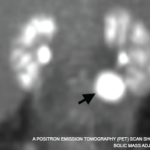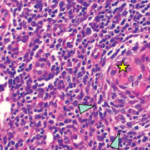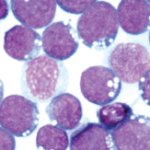James et al showed that there is an association between SLE and EBV exposure.19 Further, SLE patients have dysregulated immune responses to EBV, with EBV antigens exhibiting molecular mimicry with common SLE antigens.21 EBV antigens may give rise to autoimmunity in SLE.21,22 There are also impaired T CD8+T cell and cytokine responses to EBV.21 Some SLE patients may also have increased reactivations of EBV.21 Given the global infectious burden, however, EBV likely contributes only a small portion to the risk of SLE, with other genetic and environmental factors playing a role.
Our patient developed autoantibodies characteristic of SLE over a short period of time, which is unusual. Most data show that developments of autoantibodies precede the development of symptoms in SLE by years. In a study by Arbuckle et al, patients were positive for at least one SLE autoantibody for an average of 3.3 years before diagnosis and as early as 9.4 years. Autoantibody formation tends to follow a predictable course, with the accumulation of antibodies prior to the development of symptoms. Notably, anti-Smith and RNP are the antibodies found closest to disease presentation, occurring approximately 1.2 years before disease presentation.20
Our patient had skin tightening of her face and fingers (distal to the metacarpophalangeal joints), a tight oral aperture, telangiectasia, Raynaud’s phenomenon, digital ulcers, pitting scars on her fingertips and pulmonary hypertension by echocardiogram at presentation. Her anti-centromere, anti-scleroderma 70 and anti-RNA polymerase III antibodies were negative. She did not fulfill the 2013 ACR/EULAR classification criteria for scleroderma; however, it will not be surprising if she goes on to develop scleroderma in the future.
We treated her with an IL-6 inhibitor because she had an incomplete response to steroids.23 She improved; however, she did not follow up with the rheumatology clinic.
We report a rare case of MCD in a patient with SLE and scleroderma overlap. This case raises unanswered questions: Is this a random concomitant occurrence of Castleman disease and autoimmune disease or is this a continuum of one disease? Does the associated infection with EBV play a role in linking these diseases? This is an area that needs further exploration.
 Kwabna Parker, MBBS, is a fellow at The State University of New York Health Science Center at Brooklyn—better known as SUNY Downstate Medical Center—in the Division of Rheumatology.
Kwabna Parker, MBBS, is a fellow at The State University of New York Health Science Center at Brooklyn—better known as SUNY Downstate Medical Center—in the Division of Rheumatology.
 Sireesha Datla, MD, is a fellow at SUNY Downstate Medical Center in the Department of Hematology and Oncology.
Sireesha Datla, MD, is a fellow at SUNY Downstate Medical Center in the Department of Hematology and Oncology.
 Nancy Soloman, MD, is a rheumatology attending at SUNY Downstate Medical Center.
Nancy Soloman, MD, is a rheumatology attending at SUNY Downstate Medical Center.
Acknowledgements
The authors thank the following for their assistance in developing this article: Robert Lewis, MD, Hematology and Oncology Division, SUNY Downstate Medical Center; Jinli Liu, MD, Pathology Department, SUNY Downstate Medical Center; Chuanyong Lu, MD, Pathology Department, SUNY Downstate Medical Center; Priya Chokshi, MD, PGY-3, SUNY Downstate Medical Center; and Manile Dastagir, DO, PGY-3, SUNY Downstate Medical Center.
References
- Maslovsky I, Uriev L, Lugassy G. The heterogeneity of Castleman disease: Report of five cases and review of the literature. Am J Med Sci. 2000 Oct;320(4):292–295.
- Robinson D Jr., Reynolds M, Casper C, et al. Clinical epidemiology and treatment patterns of patients with multicentric Castleman disease: Results from two US treatment centres. Br J Haematol. 2014 Apr;165(1):39–48.
- Saeed-Abdul-Rahman I, Al-Amri AM. Castleman disease. Korean J Hematol. 2012 Sep;47(3):163–177.
- Kojima M, Motoori T, Asano S, Nakamura S. Histological diversity of reactive and atypical proliferative lymph node lesions in systemic lupus erythematosus patients. Pathol Res Pract. 2007;203(6):423–431.
- Van de Voorde K, De Raeve H, De Block CE, et al. Atypical systemic lupus erythematosus or Castleman’s disease. Acta Clin Belg. 2004 May–Jun;59(3):161–164.
- Xia JY, Chen XY, Xu F, et al, A case report of systemic lupus erythematosus combined with Castleman’s disease and literature review. Rheumatol Int. 2012 Jul;32(7):2189–2193.
- Kojima M, Nakamura S, Itoh H, et al. Systemic lupus erythematosus (SLE) lymphadenopathy presenting with histopathologic features of Castleman disease: A clinicpathologic study of five cases. Pathol Res Pract. 1997;193(8):565–571.
- Suwannaroj S, Elkins SL, McMurray RW. Systemic lupus erythematosus and Castleman’s disease. J Rheumatol. 1999 Jun;26(6):1400–1403.
- Gholke F, Märker-Hermann E, Kanzler S, et al. Autoimmune findings resembling connective tissue disease in a patient with Castleman’s disease. Clin Rheumatol. 1997 Jan;16(1):87–92.
- Hosaka S, Kondo H. [Three cases of Castleman’s disease mimicking the features of collagen disease]. [Article in Japanese] Ryumachi. 1994 Feb;34(1):42–47.
- De Paschale M, Clerici P. Serological diagnosis of Epstein- Barr virus infection: Problems and solutions. World J Virol. 2012 Feb 12;1(1):31–43.
- Serraino D, Piselli P, Angeletti Cl, et al. Infection with Epstein-Barr virus and cancer: An epidemiological review. J Biol Regul Homeost Agents. 2005 Jan-Jun;19(1–2):63–70.
- Al-Maghrabi JA, Kamel-Reid S, Bailey DJ. Lack of evidence of Epstein-Barr virus infection in patients with Castleman’s disease. Molecular genetic analysis. Neurosciences (Riyadh). 2006 Oct;11(4):279–283.
- Chen CH, Liu HC, Hung TT, Liu TP. Possible roles of Epstein-Barr virus in Castleman disease. J Cardiothorac Surg. 2009 Jul 9;4:31.
- Yamac K, Senol E, Ataoglu O, Fen T. A case report of multicentric Castleman’s disease with simultaneous Epstein-Barr virus infection. Tumori. 2001 Sep–Oct;87(5):343–345.
- Yokoi T, Miyawaki T, Yachie A, et al. Epstein-Barr virus-immortalized B cells produce IL-6 as an autocrine growth factor. Immunology. 1990 May;70(1):100–105.
- Brandt SJ, Bodine DM, Dunbar CE, Nienhuis AW. Dysregulated interleukin 6 expression produces a syndrome resembling Castleman’s disease in mice. J Clin Invest. 1990 Aug;86(2):592–599.
- Yoshizaki K, Matsuda T, Nishimoto N, et al. Pathogenic significance of interleukin-6 (IL-6/BSF-2) in Castleman’s disease. Blood. 1989 Sep;74(4):1360–1367.
- James JA, Neas BR, Moser KL, et al. Systemic lupus erythematosus in adults is associated with previous Epstein-Barr virus exposure. Arthritis Rheum. 2001 May;44(5):1122–1126.
- Arbuckle MR, McClain MT, Rubertone MV, et al. Development of autoantibodies before the clinical onset of systemic lupus erythematosus. N Engl J Med. 2003 Oct 16;349(16):1526–1533.
- James JA, Robertson JM. Lupus and Epstein-Barr. Curr Opin Rheumatol. 2012 Jul;24(4):383–388.
- Harley JB, James JA. Epstein-Barr virus infection induces lupus autoimmunity. Bull NYU Hosp Jt Dis. 2006;64(1–2):45–50.
- Liu YC, Stone K, van Rhee F. Siltuximab for multicentric Castleman disease. Expert Rev Hematol. 2014 Oct;7(5):545–557.



